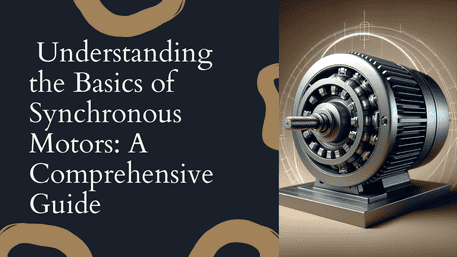Understanding the Basics of Synchronous Motors: A Comprehensive Guide
Understanding the Basics of Synchronous Motors: A Comprehensive Guide
Synchronous motors are pivotal in many industrial applications due to their precision and efficiency. This article delves into the basic principles, construction, operation, advantages, and applications of synchronous motors, providing a thorough understanding for students and professionals in electrical engineering.
What is a Synchronous Motor?
A synchronous motor is a type of alternating current (AC) motor where the rotation of the shaft is synchronized with the frequency of the supply current. In other words, the motor operates at a constant speed irrespective of the load, as long as the load does not exceed the maximum limit. This characteristic makes synchronous motors ideal for applications requiring precise and consistent speed.
Construction and Components
The construction of a synchronous motor comprises two main parts: the stator and the rotor.
Stator
The stator is the stationary part of the motor and consists of a core and a winding. The core is typically made of laminated silicon steel to reduce energy losses. The winding, usually made of copper, is distributed in slots around the stator core and connected to the AC supply.
Rotor
The rotor is the rotating part of the motor. It can be either salient pole type or non-salient pole type. The salient pole rotor has projecting poles, while the non-salient pole rotor, also known as a cylindrical rotor, has a smooth surface. The rotor is provided with direct current (DC) through slip rings, creating a constant magnetic field.
Principle of Operation
The synchronous motor operates on the principle of magnetic locking between the stator and rotor. Here's a step-by-step explanation:
- Magnetic Field Creation: When the stator winding is energized with a three-phase AC supply, it produces a rotating magnetic field.
- Rotor Magnetic Field: The DC supply to the rotor winding generates a steady magnetic field.
- Magnetic Locking: The rotor field interacts with the rotating magnetic field of the stator. The rotor tends to align with the rotating field due to the magnetic attraction between the two fields.
- Synchronous Speed: The rotor locks into synchronism with the rotating magnetic field, meaning it rotates at the same speed as the stator's magnetic field.
This synchronous speed (Ns) can be calculated using the formula: where is the supply frequency and is the number of poles.
Applications of Synchronous Motors
Synchronous motors are used in various applications due to their precise speed control and high efficiency. Common applications include:
- Power Generation: In hydroelectric and thermal power plants for driving pumps and compressors.
- Manufacturing: In industries requiring constant speed, such as textile and paper mills.
- HVAC Systems: For controlling fans and blowers where speed consistency is crucial.
- Robotics and Automation: For precise positioning and movement control.
Advantages and Disadvantages
Advantages
- Constant Speed: Synchronous motors maintain a constant speed regardless of the load, making them ideal for applications requiring precise speed control.
- Efficiency: These motors are highly efficient at converting electrical energy into mechanical energy, especially under full load conditions.
- Power Factor Correction: Synchronous motors can improve the power factor of the system by operating under leading power factor conditions.
Disadvantages
- Complex Starting Mechanism: Synchronous motors are not self-starting and require additional equipment like a variable frequency drive (VFD) or damper windings to start.
- Cost: They are generally more expensive than induction motors due to the additional components and complexity.
- Maintenance: The need for a DC power supply for the rotor adds to the maintenance requirements.
FAQs
What makes synchronous motors different from induction motors?
- Synchronous motors operate at a constant speed synchronized with the supply frequency, while induction motors have a speed that varies with the load. Additionally, induction motors are self-starting, whereas synchronous motors are not.
Why are synchronous motors preferred in certain applications?
- Synchronous motors are preferred where precise and consistent speed is required, such as in industrial processes and power generation. Their ability to operate at a leading power factor also helps in improving the overall system efficiency.
What are the common issues faced with synchronous motors?
- Common issues include difficulty in starting, the need for a DC excitation system, and the potential for losing synchronism under heavy load conditions.
Synchronous motors are integral to many industrial applications, offering advantages such as constant speed, high efficiency, and power factor correction. Understanding their construction, operation, and applications can help in selecting the right motor for specific needs and ensuring optimal performance in various industrial processes.







No comments